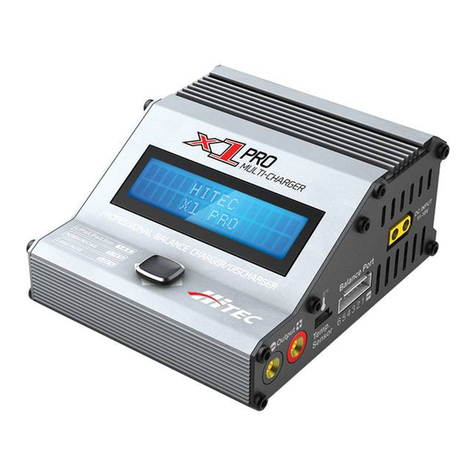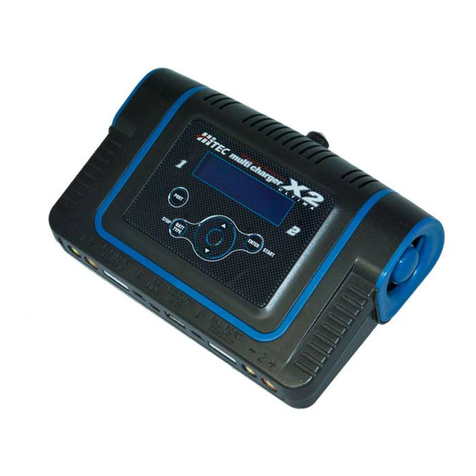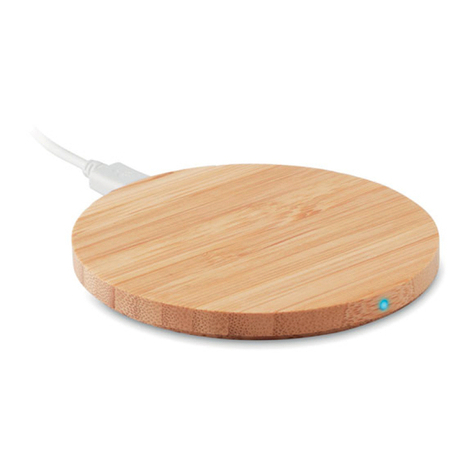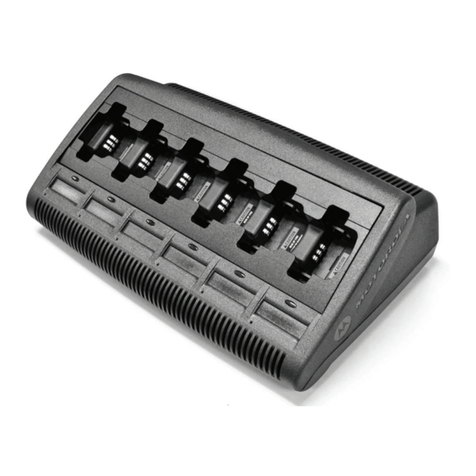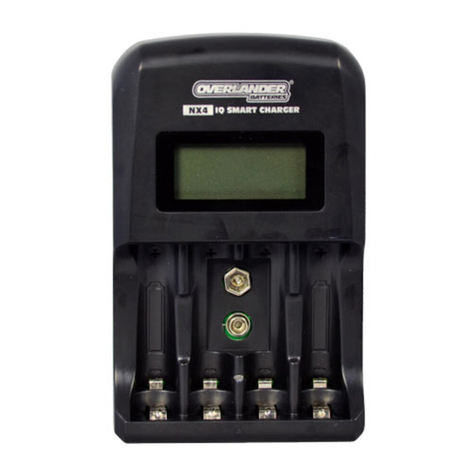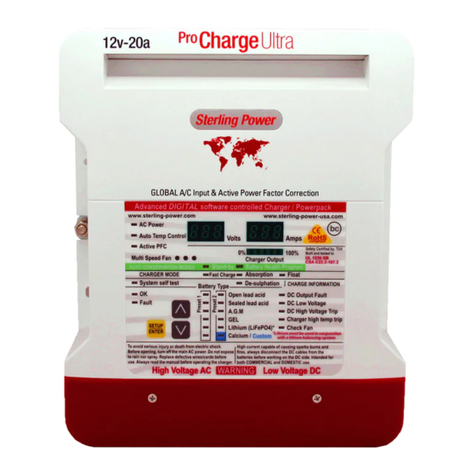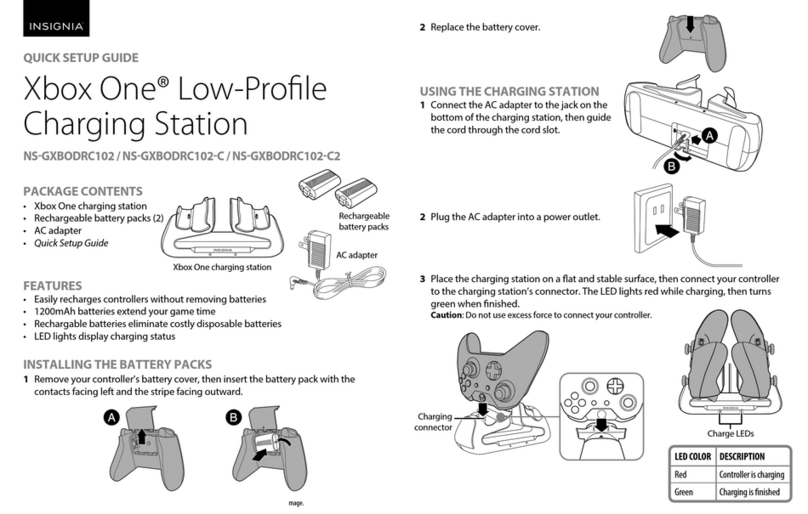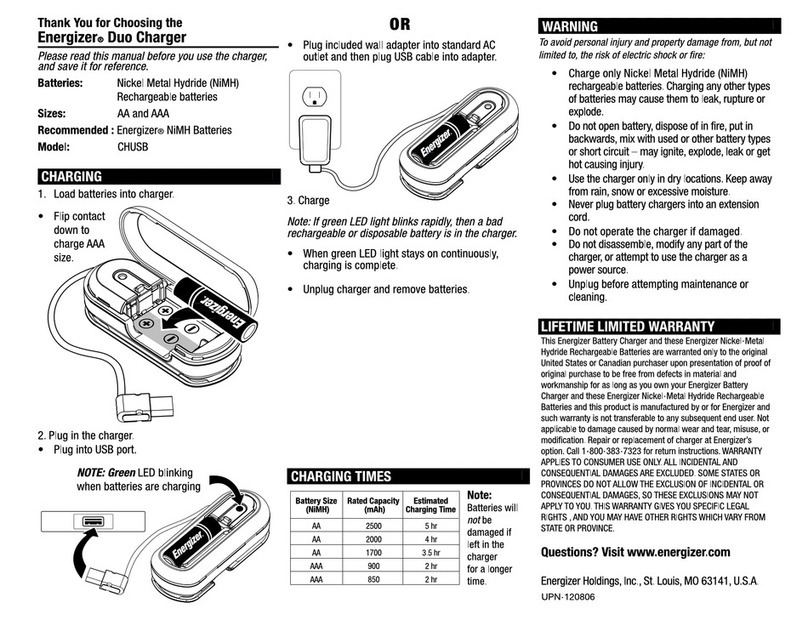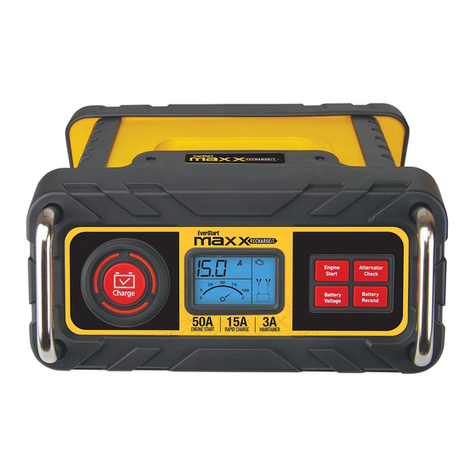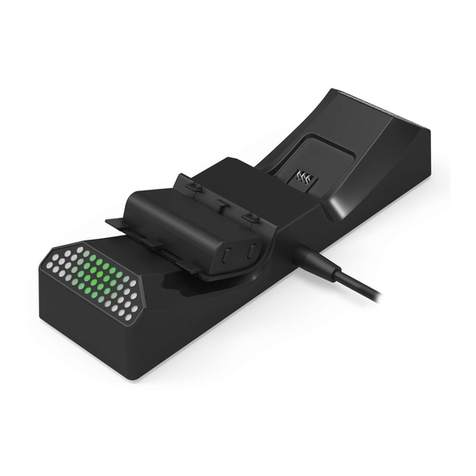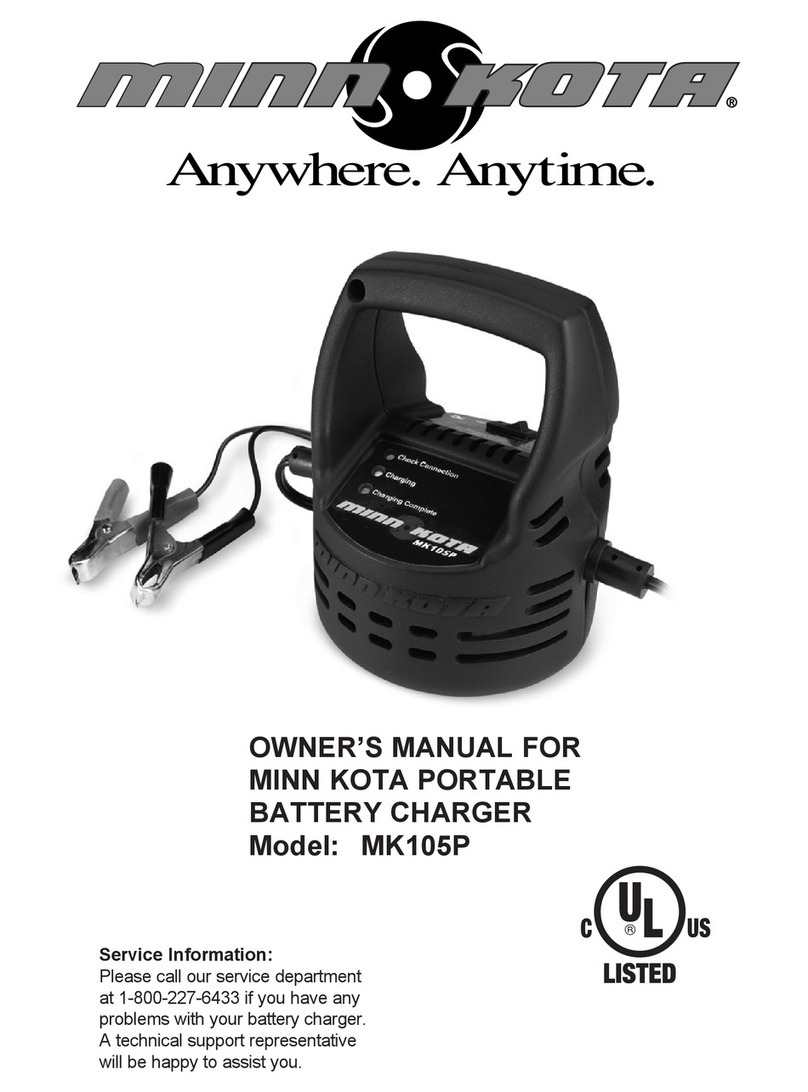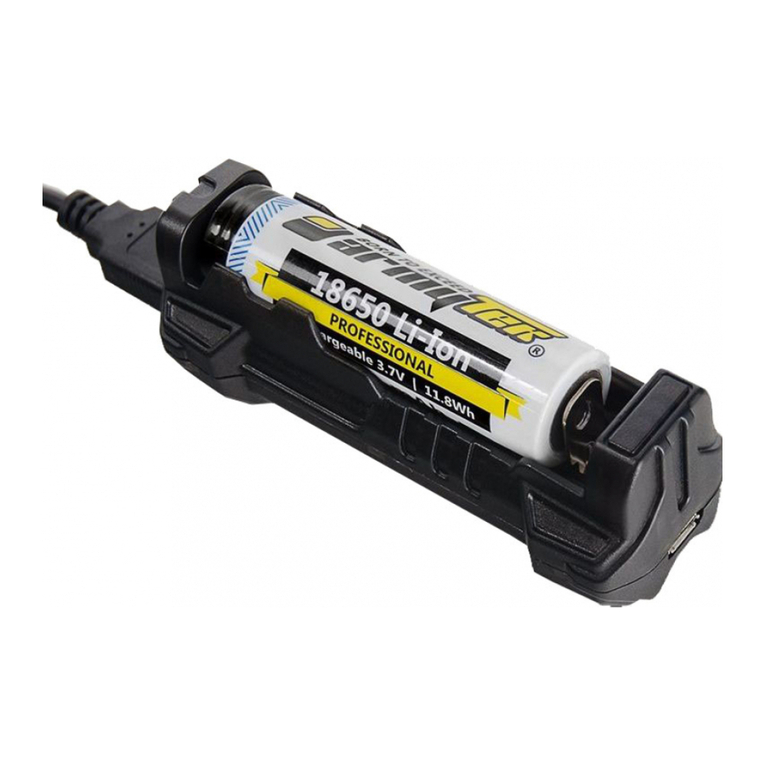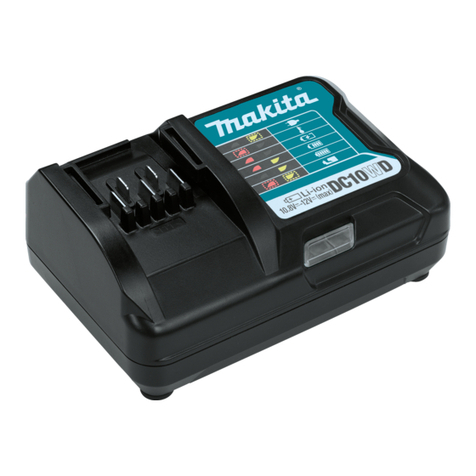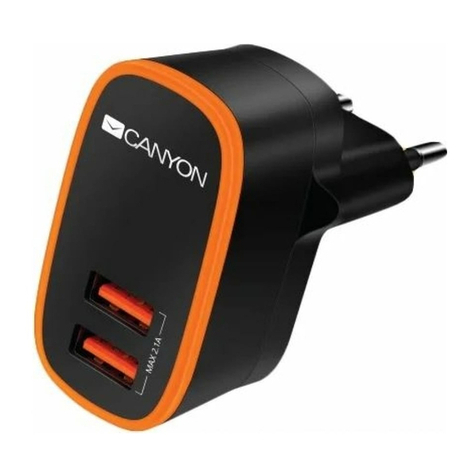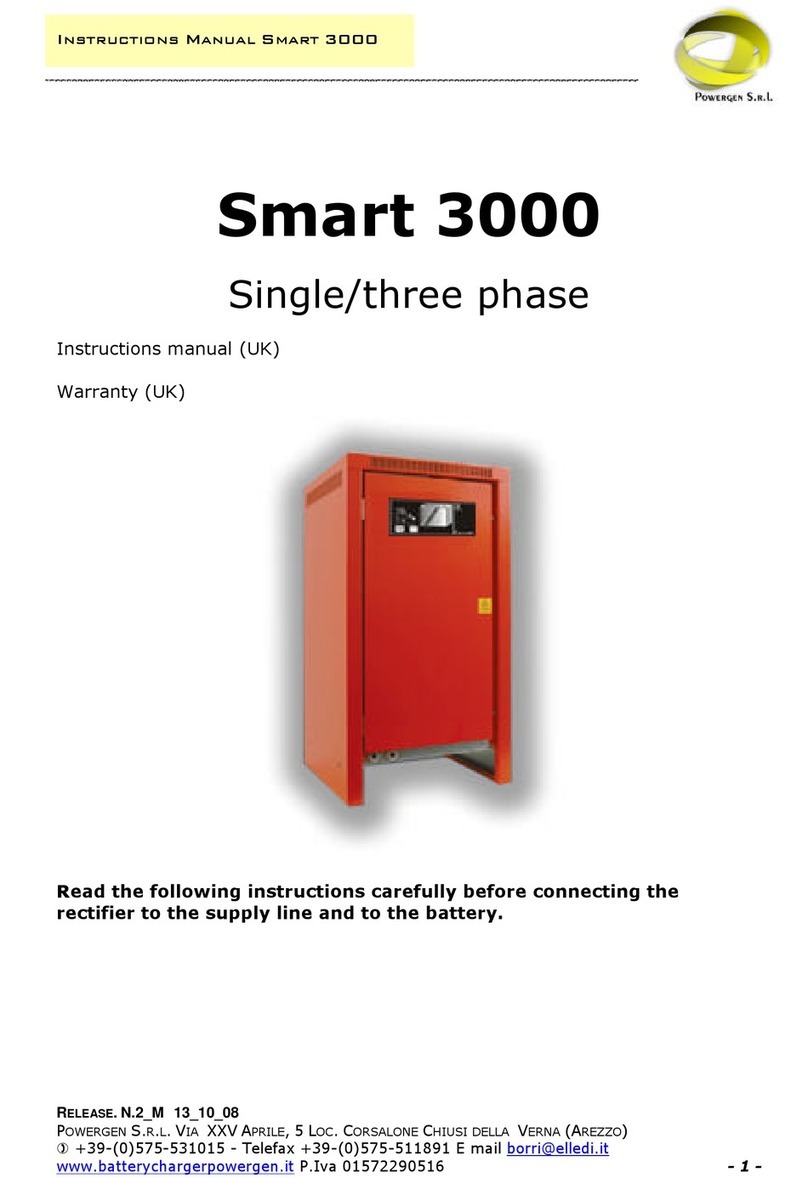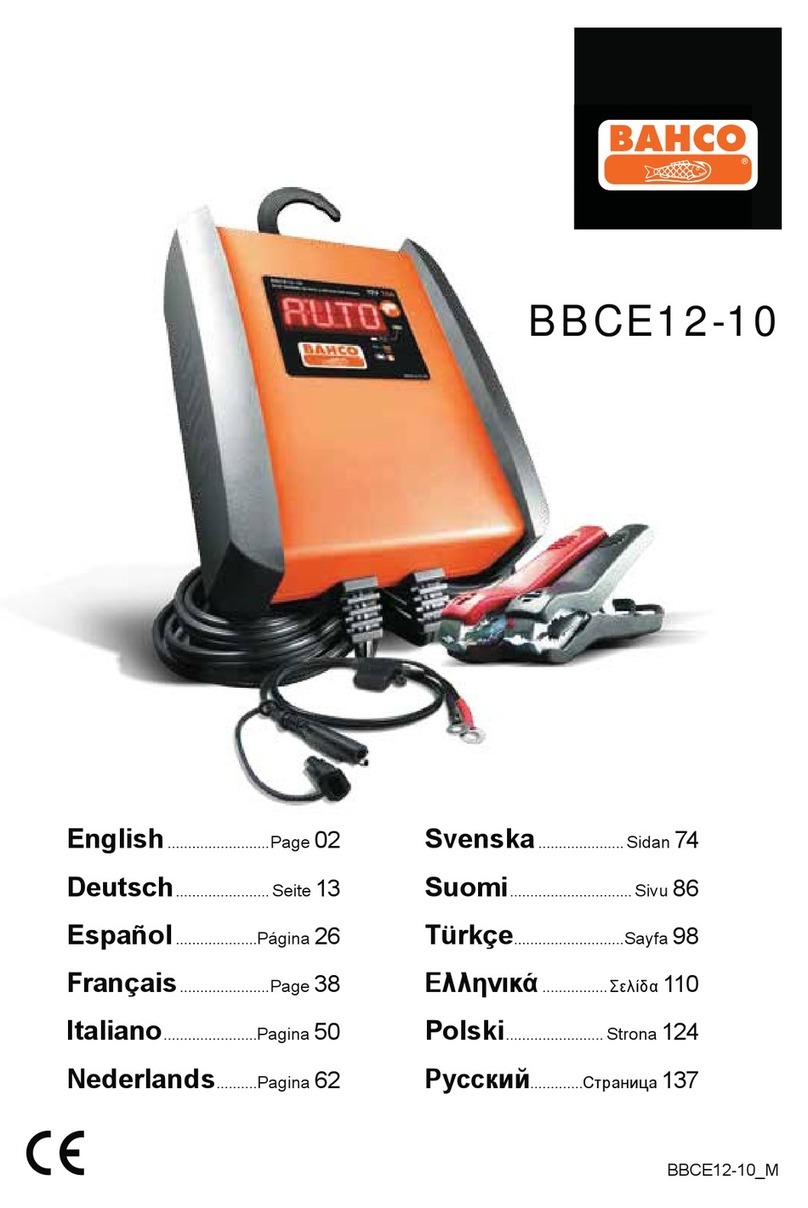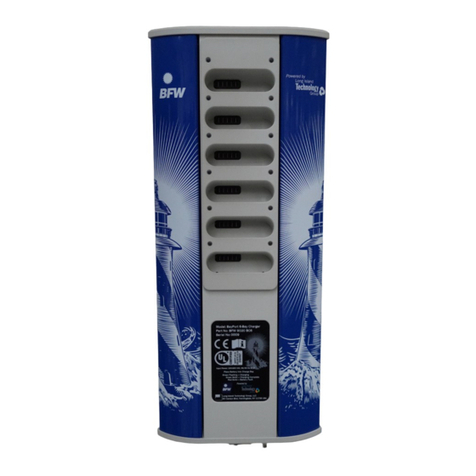Hi-Tec X1 mini User manual

OPERATION MANUAL
WARNING: THE CHARGING AND DISCHARGING OF RC HOBBY BATTERIES CAN BE DANGEROUS.
FAILURE TO FOLLOW THE INSTRUCTIONS AND WARNINGS IN THIS MANUAL MAY RESULT IN
PROPERTY DAMAGE AND/OR LOSS OF LIFE.

2 3
Congratulations on purchasing Hitec’s X1 mini compact charger! Featuring a
compact design , this sophisticated AC charger packs 60 watts into a fraction of
the size to meet your battery management requirements. Compatible with a full
range of the most popular battery types, including the new generation LiHV, the
X1 mini keeps your batteries powered up with 6-amps of charging power.
Although simple to use, the X1 mini does require some background knowledge
for successful and safe operation. The operating instructions included here are
designed to ensure that you quickly become familiar with its functions. It is
important that you read through the Operating Instructions, Warning and Safety
Notes attentively and in full before attempting to use your new charger for the
rst time. By following the guidelines and recommendations provided, you are
sure to enjoy many years of R/C fun with your new X1 mini charger!
THE CHARGING AND DISCHARGING OF RC HOBBY BATTERIES CAN BE
DANGEROUS. FAILURE TO FOLLOW THESE EXPLICIT WARNINGS CAN
RESULT IN PROPERTY DAMAGE AND/OR LOSS OF LIFE.
ANEVER LEAVE YOUR CHARGER UNATTENDED WHILE IN OPERATION.
ANEVER CHARGE ON OR AROUND COMBUSTIBLE MATERIALS.
ANEVER CHARGE A DAMAGED BATTERY PACK.
ALOW COST, NO-NAME BATTERY PACKS POSE THE MOST DANGER. WE
RECOMMEND YOU ONLY USE BATTERY PACKS THAT ARE SOLD AND
WARRANTIED BY A REPUTABLE COMPANY.
AIT IS HIGHLY RECOMMENDED THAT YOU UTILIZE A SAFETY DEVICE SUCH
AS A STEEL CASE OR LIPO SACK™ WHILE CHARGING LITHIUM CHEMISTRY
BATTERIES.
AIT IS HIGHLY RECOMMENDED THAT YOU KEEP AN OPERABLE “CLASS A” FIRE
EXTINGUISHER IN THE CHARGING AREA.
FAILURE TO FOLLOW THESE WARNINGS CAN BE CONSIDERED
NEGLIGENCE BY THE OPERATOR AND MAY NEGATE ANY CLAIMS
FOR DAMAGES INCURRED.
Table of Contents:
Introduction..................................................................................................................................03
Warning and Safety Notes.....................................................................................................04
Product Layout............................................................................................................................08
Specications................................................................................................................................09
Features..........................................................................................................................................10
Battery Connections................................................................................................................12
Input Functions ..........................................................................................................................13
Program Flow Chart..................................................................................................................14
Charger Operation....................................................................................................................16
Memory Preset - Data Store/Load......................................................................................18
Battery Meter...............................................................................................................................20
Battery Resistance Meter........................................................................................................21
Advanced System Set Up........................................................................................................22
Warning and Error Messages................................................................................................24
Using Charge Master PC Software .....................................................................................25
Commonly Used Terms............................................................................................................25
Conformity Declarations........................................................................................................27
Disposal and Prop 65 Warning............................................................................................28
Warranty and Service...............................................................................................................28
Warning
Table of Contents Introduction
Warning

4 5
These warnings and safety notes are of the utmost importance. You must follow
these instructions for maximum safety. Failure to do so can damage the charger
and the battery and in the worst cases, may cause a re.
NEVER LEAVE THE CHARGER UNATTENDED WHILE IT IS CONNECTED TO
ITS POWER SOURCE. IF ANY MALFUNCTION IS FOUND, TERMINATE THE
PROCESS AT ONCE AND REFER TO THE OPERATION MANUAL.
AThe allowable DC input voltage is 11-18V DC.
AThe allowable AC input voltage is 100-240V AC.
AKeep the charger away from dust, damp, rain, heat, direct sunlight and
excessive vibration.
AIf the charger is dropped or suers any type of impact, it should be inspected
by an authorized service station before using it again.
AThis charger and the battery should be put on a heat-resistant, non-
ammable and non-conductive surface.
ANever place a charger on a car seat, carpet or similar surface. Keep all
ammable volatile materials away from the operating area.
AMake sure you know the specications of the battery to be charged or
discharged to ensure it meets the requirements of this charger. If the
program is set up incorrectly, the battery and charger can be damaged.
AFire or explosion can occur due to overcharging.
Warning
Warning: Be sure to read this section for your own safety.
Caution: Be sure to read this section to prevent accidents
and damage to your charger.
Tip: This section will help you maximize the performance of
your charger.
Note: This section will provide more detailed explanations.
Caution
Tip
Warning
Note
ATo avoid a short circuit between the charge lead, always connect the charge
cable to the charger rst, then connect the battery. Reverse the sequence
when disconnecting.
ANever attempt to charge or discharge the following types of batteries:
• A battery tted with an integral charge circuit or a protection circuit
• A battery pack which consists of dierent types of cells (including
dierent manufacturer’s cells)
• A battery that is already fully charged or just slightly discharged and
non-rechargeable batteries (these pose an explosion hazard)
• A faulty or damaged battery
• Batteries installed in a device or which are electrically linked to other
components
• Batteries that are not expressly stated by the manufacturer to be
suitable for the currents the charger delivers during the charge process
PLEASE BEAR IN MIND THE FOLLOWING POINTS BEFORE YOU
COMMENCE CHARGING:
• Did you select the appropriate program suitable for the type of battery you
are charging?
• Did you set up the adequate current for charging or discharging?
• Have you checked the battery voltage? Lithium battery packs can be wired
in parallel and in series, i.e. a 2-cell pack can be 3.7V (in parallel) or 7.4V (in
series).
• Have you checked that all connections are rm and secure?
• Make sure there are no intermittent contacts at any point in the circuit.
Warning and Safety Notes Warning and Safety Notes [cont.]
Hitec RCD USA will not be held responsible for any damages or injuries that may
occur by persons who fail to follow these warnings or who fail to properly follow
the instructions in this manual.

6 7
LiPo LiPo HV LiIon LiFe NiCd NiMH Pb
Nominal
Voltage
3.7V/cell 3.7V/cell 3.6V/cell 3.3V/cell 1.2V/cell 1.2V/cell 2.0V/cell
Max. Charge
Voltage
4.2V/cell 4.35V/cell 4.1V/cell 3.6V/cell 1.5V/cell 1.5V/cell 2.46V/cell
Storage
Voltage
3.8V/cell 3.85V/cell 3.7V/cell 3.3V/cell n/a n/a n/a
Allowable Fast
Charge
≤ 1C ≤ 1C ≤ 1C ≤ 4C ≤ 1-2C ≤ 1-2C ≤ .04C
Min. Discharge
Voltage
3.0-3.3V/cell 3.1-3.4V/cell 2.9-3.2V/cell 2.6-2.9V/cell 0.1-1.1V/cell 0.1-1.1V/cell 1.8V/cell
Standard Battery Parameters
WHEN ADJUSTING YOUR X1 MINI CHARGING PARAMETERS, BE SURE
YOU SELECTTHE PROPER BATTERYTYPE AND CELLVOLTAGE FOR THETYPE
OF CELL YOU ARE CHARGING. CHARGING BATTERIES WITH THE WRONG
SETTINGS MAY CAUSETHE CELLS TO BURST, CATCH FIRE OR EXPLODE.
Charging
Before charging your batteries, it is critical that you determine the maximum
allowable charge rate for your batteries. The X1 mini is capable of charging
at high rates that may not be suitable or safe for your particular batteries. For
example, Lithium cells are typically safe to charge at 1C, or the total mAh÷1000.
A 1200mAh battery would have a 1C charge rate of 1.2 amps. A 4200mAh
battery would have a 1C charge rate of 4.2 amps. Some manufacturers are
oering Lithium cells that can be charged at greater than 1C but this should
ALWAYS be veried before charging a Lithium battery at rates higher than 1C.
Voltage is just as critical as the charging amperage rate and this is determined
by the number of cells in series, or“S”. For example, a 3S LiPo is rated at 11.1 volts
(“S”multiplied by a single LiPo cell with a nominal voltage of 3.7 volts DC. 3 cells
x 3.7 volts each equals 11.1 volts DC).
Connect the battery’s main leads to the charger output: red is positive and
black is negative. Keep in mind that the gauge or thickness of your charging
leads from the X1 mini to your battery must be of an acceptable current rating
to handle the applied charge current. For maximum safety and charging
eectiveness, always match or exceed the main battery lead rating when
assembling or selecting your charging leads. If you charge a battery at a high
current rate (amperage) with a charging lead not rated for the chosen amperage,
the wire could get hot, catch re, short out and/or potentially destroy your
battery and the charger.
Warning
When in doubt, always use a higher gauge wire (lower AWG number). It is
common to see charging leads constructed of 14AWG, 16AWG or 18AWG wire.
Always refer to recommendations from your battery manufacturer for your
specic battery type and size before initiating a charge or discharge process.
Do not attempt to disassemble or modify Lithium or Lead-Acid battery packs.
Discharging
The X1 mini discharging functions are for two specic purposes:
• Refreshing the capacity of a Nickel-based battery that has lost capacity over
time (NiMH or NiCd).
• Reducing the voltage of a Lithium battery for safe storage.
LITHIUM CHEMISTRY BATTERY PACKS SHOULD ONLY BE DISCHARGED
TO THEIR MINIMUM SAFE VOLTAGE, NO LOWER. DEEP DISCHARGING
A LITHIUM CELL WILL DO PERMANENT DAMAGE. REFER TO THE
STANDARD BATTERY PARAMETERS TABLE ON PAGE 6 OF THIS MANUAL
FOR MINIMUM DISCHARGE VOLTAGES.
LiPo & LiHV Charge/Discharge Cycling
Lithium batteries are known to reach full capacity after a break-in period of
about 10 charge/discharge cycles. We do not recommend you use the X1 mini
charger to do this; normal use and recharging will achieve the same results.
If you wish to perform a Lithium break-in on the bench with the X1 mini,
discharging to minimum acceptable voltages and performing a balance charge
at 1C maximum rate is recommended. If you choose to break in your Lithium
batteries under normal use, charging at only 1C for the rst ten cycles will help
ensure full performance and service life from your Lithium cells.
Warning and Safety Notes [cont.] Warning and Safety Notes [cont.]
Note

8 9
Product Layout Specications
In the case of an error, the screen will communicate the cause of the error and
emit an audible sound.
The Set Contains:
1 x X1 mini Charger
1 x Power Cord
1 x 2 Pin T-Type Battery Charge Cable
1 x XT60 Battery Charge Cable
X1 mini Specications
AC Input
Total Charge Circuit Power
Charge Current Range
Discharge Current Range
Discharge Current Power
Current Drain for LiPo Balancing
100 - 240 Volts AC
60 Watts AC input
0.1 - 6.0 Amps
0.1 - 2.0 Amps
10 Watts
Max 200mA per cell
NiCd/NiMH Battery Cell Count 6 - 8 Cells
- Capacity Range 100 - 50000mAh
LiPo/LiHV/LiFe/Lilon Cell Count 2 - 4 Cells
- Capacity Range 100 - 50000mAh
Pb Battery Voltage 6 - 12 Volts
- Capacity Range 100 - 50000mAh
0.68 lbs
310g
Net Weight
4.41 x 4.17 x 2.05in
112 x 106 x 52mm
Dimensions

10 11
Fast and Storage Mode of Lithium Battery:
Depending on your application requirements, you may choose fast charge or
storage mode. Fast charge reduces the amount of time required for charging,
whereas ‘store’ state controls the nal voltage of your battery.
Re-Peak Mode of NiMH/NiCd Battery:
In re-peak charge mode, the charger can peak charge the battery once, twice,
or three times in a row automatically. This function is useful for ensuring a full
battery charge.
Delta-Peak Sensitivity for NiMH/NiCd:
This automatic charge termination program is based on the principle of the
Delta-peak voltage detection. When the battery’s voltage exceeds the threshold,
the process will be terminated automatically.
Cyclic Charging/Discharging:
1 to 5 cyclic and continuous charge > discharge or discharge > charge sessions
are optimal for battery performance and balancing.
Automatic Charging Current Limit:
You can set the upper limit of the charging current when charging your NiMH
or NiCd battery. The ‘AUTO’ charging mode, however, is recommended when
charging NiMH batteries with low impedance and capacity.
Battery Meter:
The user can check the battery’s total voltage, the highest voltage, the lowest
voltage and the voltage of each cell. The user can also check the battery’s total
internal resistance and the internal resistance of each cell.
Capacity Limit:
The charging capacity is always calculated as the charging current multiplied by
time. If the charging capacity exceeds the limit, the process will automatically
terminate according to the maximum value previously set.
Temperature Threshold*:
The battery’s internal chemical reaction will cause the temperature of the
battery to rise. If the temperature limit is reached, the process will be terminated.
* This function is available by connecting an optional temperature probe which
is available as a separate purchase.
Processing Time Limit:
Protect your battery by setting a maximum time limit for charging and discharging.
Features Features [cont.]
Optimized Operating Software:
The X1 mini features the user-friendly AUTO function that sets the feeding
current during the process of charging or discharging. For lithium batteries
especially, it can prevent overcharging and any resulting consequences. With
the AUTO function, users can disconnect the circuit automatically and trigger
a single alarm to sound if any malfunction has been detected. All programs
unique to the X1 mini are controllable through a two-way linkage and
communication system intended to maximize safety and minimize the trouble.
Every setting is customizable according to user preference.
Battery Memory (Data Store/Load):
The X1 mini is capable of storing up to 10 dierent charge/discharge proles for
your convenience. Users can keep the data pertaining to any program setting for
any battery to facilitate seamless charging or discharging. Saved proles can be
accessed and recalled as necessary.
Terminal Voltage Control(TVC):
For experienced users, the charger’s end voltage can be reset.
“Charge Master” PC Control Software:
Compatible with the with downloadable“Charge Master” software, the X1 mini
gives you unparalleled ability to operate the charger via your personal computer.
You can monitor pack voltage, cell voltage, and other data during battery
charging or view the charge data in real-time graphs. The “Charge Master” gives
you the option to initiate and update rmware as well.
Internal Independent Lithium Battery Balancer:
The X1 mini employs an individual-cell-voltage balancer. It is not necessary to
connect an external balancer for balance charging.
Individual Cell Balancing While Discharging:
During the discharge process, the X1 mini can monitor and balance each cell
of the battery individually. If the voltage of any single cell reads abnormally, an
error message will display and end the process automatically.
Adaptable to Various Types of Lithium Battery:
The X1 mini is adaptable to various types of lithium batteries, including LiPo,
LiIon, LiFe and the new LiHV batteries.

12 13
Battery & Power Supply Connections
TO AVOID SHORT CIRCUITS, ALWAYS CONNECT THE CHARGE LEADS
TO THE CHARGER FIRST, AND THEN TO THE BATTERY. REVERSE THE
SEQUENCE WHEN DISCONNECTING THE PACK.
Warning
Battery Connection With Balance Adaptor.
2S 3S 4S 5S
6S
1
2
3
4
5
6
BATTERY
DC 11-18V BALANCE
SOCKET
BALANCE ADAPTOR
X1 CHARGER
BALANCE
LEAD
1.) Connecting to Power Source:
It is an AC charger only. Please insert the AC power cord to the wall socket (100-
240V) directly to power it on.
2.) Connecting the Battery:
Important!!! Before connecting a battery, it is absolutely essential to check one
last time that you have set the parameters correctly. If the settings are incorrect,
the battery may be damaged and could even burst into ames or explode. To
avoid short circuits between the banana plugs, always connect the charge leads
to the charger rst and only then to the battery. Reverse the sequence when
disconnecting the pack.
3.) Balance Socket:
In default setting, for safety issue, it requests to use balance charging wire with
balance board to charge Lithium batteries in all modes. If the charging
battery has no balance wire, please disable this function in system setting
program as following:
BATT PROG / STOP Button:
Stop a function in-progress or to go back to previous step/screen.
DEC Button:
Scroll through menus or decrease the parameter value.
INC Button:
Scroll through the menus or increase the parameter value.
ENTER / START Button:
Enter parameters or store parameters on-screen. Start the charge/discharge
process.
When changing a parameter value in the program, press the START/ENTER
button to make it blink, then change the value by pressing the DEC and INC
button. The value will be stored by repressing the START/ENTER button. If there
is a second parameter to edit on the same screen, it will begin blinking after you
conrm the rst parameter value.
When you rst power the charger on it displays the last processes used. From
here you can change the battery type or press enter to change the charge/
discharge process, charge/discharge current rate and/or battery cell count. If
you are charging a battery identical to the last one used and want to perform
the same process then simply press the start to begin that process.
Input Functions

14 15
INC DEC
BATT/PROGRAM
START
LiPo BALANCE CHG
INC
INC
INC
INC
LiPo BATT
ENTER
2.0A 7.4V (2S)
DEC
DEC
DEC
DEC
INC DEC
BATT/PROGRAM
START
LiFe BALANCE CHG
INC
INC
INC
INC
LiFe BATT
ENTER
2.0A 6.6V (2S)
DEC
DEC
DEC
DEC
INC DEC
BATT/PROGRAM
START Lilo BALANCE CHG
INC
INC
INC
INC
LiIo BATT
ENTER
2.0A 7.2V (2S)
DEC
DEC
DEC
DEC
INC DEC
BATT/PROGRAM
START
LiHV BALANCE CHG
INC
INC
INC
INC
LiHV BATT
ENTER
2.0A 7 .4V (2S)
DEC
DEC
DEC
DEC
INC DEC
BATT/PROGRAM
START N iMH CHARGE
INC
INC NiMHDISCHARGE
INC
INC
NiMH BATT
ENTER
CURRENT 2.0A
DEC
DEC
0.1A CUT: 1.0 V
DEC
DEC
INC DEC
BATT/PROGRAM
START
NiCd CHARGE
INC
INC NiCd DISCHARGE
INC
INC
NiCd BATT
ENTER
CURRENT 2.0A
DEC
DEC
0.1A CUT: 1.0V
DEC
DEC
INC DEC
BATT/PROGRAM
START
Pb CHARGE
INC
Pb BATT
ENTER
2.0A 2.0V (1P)
DEC
INC DEC
BATT/PROGRAM
START MAIN 0.00V
(Connect the main battery socket)
BATT METER ENTER
INC DEC
INC
DEC
(Connect battery via balance board)
BATT/PROGRAM
BATT RESISTANCE
START 005 003 003 m IN C
ENTER 005 m DEC
INC DEC
BATT/PROGRAM
START Safety Timer
INC
INC
INC
INC
INC
SYSTEM SETTING-> ENTER ON
120Min
DEC
DEC
DEC
DEC
DEC
INC DEC
Stop
Batt Type
INC
DEC
INC
DEC
INC
DEC
INC
DEC
INC DEC
BATT/PROGRAM
START
[BATT ME MORY 1 ]
START
BATT TYPE
INC
INC
INC
INC
BATT MEMORY ENTE R
ENTER SET->
ENTER
LiPo
DEC
DEC
DEC
DEC
STARG/ENTER>3 Seconds
INC DEC
INC
DEC
INC
DEC
INC
DEC
INC
DEC
INC
DEC
ENTER
[ BATT ME MORY 2 ] ST ART BATT TYPE
INC
INC
INC
INC
START
ENTER SET->
ENTER MiMH
DEC
DEC
DEC
DEC
SAVE PROGRAM
START SAVE PROGRAM
INC
INC
INC DEC
SAVE.
ENTER
ENTER
DEC
DEC
INC
DEC
INC
DEC
INC
DEC
INC
DEC
INC
DEC
ENTER
[ BATT ME MORY 3 ] STA RT BATT TYPE
INC
INC
INC
INC
START
ENTER SET->
ENTER
Pb
DEC
DEC
DEC
DEC
Program Flow Chart
For larger version visit www.hitecrcd.com
Charger Operation
Note: You should set up the upper limit of the charge current to
avoid damage by excessive feeding current. Some batteries of low
resistance and capacity can lead to higher current.
lithium battery which
NiMH
NiCd
RE-PEAK
CYCLE
Pb
Batt
Type
Operation
Program Description
This charging mode is for charging LiPo/LiFe/LiIon/LiHV battery in normal mode.
This program is for charging or discharging
will not be used for long time.
The charging capacity may be less than normal charging but the
process time will be reduced.
This mode is for balancing the voltage of lithium-polymer battery
cells while charging.
The charger will charge NiMH and NiCd batteries using the
charge current set by the user.
In this program the charger detects the condition of the battery
which is connected to the output and automatically charges the
battery.
In re-peak charge mode, the charger can peak charge the
battery once, twice or three times in a row automatically. This is
good for confirming the battery is fully charged, and for checking
how well the battery receives fast charges.
1 to 5 cyclic and continuous process of charge>discharge or
discharge>charge is operable for battery refreshing and
balancing to stimulate the battery's activity.
LiPo
Lilon
LiFe
LiHV
CHARGE
DISCHARGE
STORAGE
FAST CHG
BAL CHARGE
CHARGE
AUTO CHG
DISCHARGE
CHARGE
DISCHARGE
This mode is for discharging LiPo/LiFe/LiIon/LiHV battery.
This mode is for discharging NiMH/NiCd battery.
This mode is for charging Pb battery.
This mode is for discharging Pb battery.
It is highly recommended to have the owchart handy while learning to operate
this charger. There are two main ways to setup the charger:
(1) Memory prole are available for setting and storing charge or discharge
parameters for up to 10 dierent batteries. Once a battery’s information is
stored into memory, it will be retained until changed again manually. Recalling a
battery’s memory number makes the charger instantly ready to go!
(2) The other method is by manually setting up the charge or discharge process
each time. The X1 mini is capable of the following processes:

16 17
Charger Operation [cont.]
The following steps describe how to manualy setup the X1 mini:
Charger Operation [cont.]
3. BATT/PROGRAM Select: Press INC and DEC to
scroll through all programs and press START/ENTER
to enter the LiPo BATT Program.
4. Mode Select: Press INC and DEC to scroll through
all modes and press START/ENTER to enter LiPo
Balance Charge Mode.
5. Battery Setting: Press START/ENTER. The current
value will start to blink, Press INC and DEC to
change the value and press START/ENTER to conrm
your setting.
At the same time, the battery cell’s number will start
to blink. Press INC and DEC to change the value and
press START/ENTER to conrm your setting.
6. Program Start: Press and hold START/ENTER for 3
seconds to start the program.
The charger is detecting the number of cells.
R shows the number of cells detected by the
charger and S is the number of cells set by the
user at the previous screen. If the numbers are not
identical, press STOP to go back to the previous
screen and recheck the number of cells in the
battery pack before proceeding.
L P 4 s 1 . 5 A 1 2 . 1 4 V
B A L 0 0 0 : 5 0 0 0 0 2 2
INC
4 . 0 7 4 . 0 6 4 . 1 1 V
0 . 0 0 0 . 0 0 0 . 0 0 V
INC
F u e l = 9 0 % C
e l l = 4 . 1 0 V
L P 4 s 1 . 5 A 1 2 . 1 4 V
B A L 0 0 0 : 5 0 0 0 0 2 2
DEC
DEC
Ext. Temp ----
Int. Temp 37 C
DEC
Temp Cut- Off
50 C
DEC
DEC
If both numbers are identical, press START/ENTER to begin
the charging process.
Information Displayed While Operating
Pressing INC or DEC during the charging or discharging process allows the user
to view a variety of information on the LCD screen.
Real-time status: battery type, battery cell, charge current,
battery voltage, elapsed time and charged capacity.
7. Charging Status Monitor: During the charge process, the
real-time status will be visible on the left side of the screen.
Voltage of each cell in the battery pack when the battery is
connected with balance lead.
Charged capacity percentage and average cell voltage of the
battery pack.
Cut o temperature.
Final voltage when the program ends.
Internal and External temperature.
(Temperature probe required to show external temperature.)
Capacity cut-o ON and the setting value of capacity.
Safety timer ON and duration of time in minutes.
8. Program Stop: During the charging process, press STOP
to stop the charging process.
9. Program Complete: When the charging process nishes, an audible sound will play.

18 19
Memory Preset - Data Save/Load
Memory Preset - Data Save/Load:
The Save Data and Load Data programs make it easy to store and load charge and
discharge proles for up to 10 batteries per channel. Data can be saved for each
battery type and each charge mode available with the X1 mini. This allows you to
recall data for each battery when charging or discharging without having to set up
the program over again. You can also edit settings for each saved battery.
Save Data:
From the BATT/PROGRAM menu use the + or ▬buttons
to scroll to the BATT MEMORY program and press the
ENTER/Start ►button to enter the battery memory program. In the corner of
the screen you will see the number 1 ashing, use the + or ▬buttons to scroll
to scroll through the memories. When you are ready to select a memory to
program, press the ►button again to enter the memory setup menu.
Press the ►button again and the battery type will begin
to ash. Use the + or ▬buttons to select the battery type
(LiPo, LiFe, LiIon, LiHV, NiMH, NiCd or Pb, then press the ►button to conrm
your selection.
Now you will use + or ▬buttons to scroll through the battery parameters, using
the +you will make adjustments in the following order, using the ▬ button will
reverse this order.
Voltage and Number of Cells: Press the ►button and
the number of cells will begin to ash. Use the + or ▬
buttons to change the cell count then press the ►button to conrm your selection.
Charge Current: Press the ►button and the charge
current value will begin to ash. Use the +or ▬buttons
to change the charge current then press the ►button to conrm your selection.
Discharge Current: Press the ►button and the discharge
current value will begin to ash. Use the + or ▬buttons
to change the discharge current then press the ►button to conrm your
selection.
[BATT MEMORY 1]
ENTER SET ->
BATT TYPE
LiPo
BATT VOLTS
7.4V ( 2S )
CHARGE CURRENT
4.9A
DSCH CURRENT
2.0A
Per Cell Discharge Voltage: Press the ►button and the
per cell discharge voltage value will begin to ash. Use
the + or ▬buttons to change the per cell discharge voltage, then press the ►
button to conrm your selection.
MAKE SURE TO FOLLOW YOUR BATTERY MANUFACTURERS
RECOMMENDATIONS REGARDING DISCHARGING. FAILURE TO DO SO
MAY DESTROY THE BATTERY OR RENDER IT UNSAFE FOR USE.
Terminal Voltage: Press the ►button and the terminal
voltage value will begin to ash. Use the + or ▬buttons
to change the terminal voltage, and then press the ►button to conrm your
selection.
CHANGING THE TERMINAL VOLTAGE IS ONLY INTENDED FOR EXPERT
USERS, ANY CHANGES TO DEFAULT SETTINGS ARE COMPLETELY AT YOUR
OWN RISK.
Save Program: Press the ►button to save the program.
SAVE….. will appear momentarily while the program is
written to the memory.
Once saved the screen indicate the memory number,
battery type, cell count, charge current and discharge
current.
Recall Memory:
From the BATT/PROGRAM menu use the + or ▬buttons to
scroll to the BATT MEMORY program and press ►button
to enter the battery memory program . Use the + or ▬buttons to scroll to scroll
through the memories. When you have found the memory you would like to use
press and the ►button again to recall the memory.
Use the + or ▬buttons to scroll the available proceses
(charge, discharge, balance charge etc.). Select the process
you would like to execute for the battery then press and hold the ►button for 3
seconds to begin the selected process.
Memory Preset - Data Save/Load [cont.]
DSCH VOLTAGE
3.0V/CELL
Warning
TVC = YOU R RISK
4.20V
Warning
SAVE PROGRAM
ENTER
SAVE PROGRAM
SAVE...
[ BATT MEMORY 1 ]
LiPo 7.4V (2S)
[ BATT MEMORY 1 ]
C:4.9 D:2.2 A
ENTER CHARGER
LOAD...
LiPo BALANCE CHG
4.9A 7.4V (2S)

20 21
Battery Meter
Battery Meter:
The user can check the battery’s total voltage, the highest voltage, the lowest
voltage and each cell’s voltage in the battery pack.
Connect the battery to the charger by inserting the main battery lead to the
battery socket and balance wires to balance socket.
Press the START/ENTER button to access the Lithium Battery
Meter program.
Indicates each cell’s voltage.
Indicates the total voltage, the highest voltage and the
lowest voltage.
BATT/PROGRAM
BATT METER
4.20 4.19 4.19V
4.18 4.18 4.19V
MAIN 25.13V
H4.200 V L4.182V
This diagram shows
t
he correct way to
c
onnect your battery
to check the voltage.
Battery Resistance Measurement:
The user can check the battery’s total resistance, the highest resistance, the
lowest resistance and each cell’s resistance in the battery pack.
Connect the battery to the charger by inserting the main battery lead to the
battery socket and balance wires to balance socket.
Press the START/ENTER button to access the Lithium
Battery Resistance program.
The rst screen indicates each cell’s internal resistance.
Indicates the total resistance, the highest resistance and
the lowest resistance.
Battery Resistance Measurement
BATT/PROGRAM
BATT RESISTANCE
012 005 005 mΩ
006 mΩ
TOTAL: mΩ
H:12mΩL:5mΩ
This diagram shows
t
he correct way to
c
onnect your battery
to check the voltage.
This diagram shows
t
he correct way to
c
onnect your battery
to check the voltage.

22 23
Advanced System Set Up
The system will be set to its default parameters when powered on for the rst
time. The screen displays the following information in sequence and the user can
change any given value on each screen.
To change a parameter value in the program, press START/ENTER to make that
value blink. Next, change the value by pressing INC or DEC. The value will be
stored by pressing START/ENTER once.
Safet y T imer
O N 1 20Mi n
Res t T ime
CHG>DCH G 1 0Min
Capacit y C ut-Off
O N 5 000mAH
Temperatur e U nit
C elsius
Tem p C ut-Of f
O N 5 0 °C 1 22 °F
This p rogram sets the maximum charge
capacity that will be supplied to t he battery
during charge. If the delta peak voltage is
not detected nor the safety timer expired by
any reason, t his feature will automatically
stop the process at t he selected capacity
value.
When you start a charge process, t he
integral safety timer automatically s tarts
running at t he s ame time. This i s
programmed to p revent overcharge the
battery i f it p roves to be faulty, or i f the
termination circuit cannot detect the battery
full. The value for the safety timer should be
generous enough to a llow a full charge of
the battery.
The battery's internal chemical reaction will
cause the temperature of t he battery t o
rise. If the temperature limit is reached, the
process will be terminated.
OFF/
ON
(100-50000 mAh)
ITEM SELECTION DESCRIPTION
OFF/
ON
(1-720 Min)
OFF/
ON
(20 C/68 F -
80 C/176 F)
Celsius
Fahrenheit
1-60Min A rest t ime allowing the battery t o cool
down between charging/discharging cycle.
You can choose the temperature displayed
by Celsius or Fahrenheit as you like.
Safet y T imer
O N 1 20Mi n
Res t T ime
CHG>DCH G 1 0Min
Capacit y C ut-Off
O N 5 000mAH
Temperatur e U nit
C elsius
Tem p C ut-Of f
O N 5 0 °C 1 22 °F
This p rogram sets the maximum charge
capacity that will be supplied to t he battery
during charge. If the delta peak voltage is
not detected nor the safety timer expired by
any reason, t his feature will automatically
stop the process at t he selected capacity
value.
When you start a charge process, t he
integral safety timer automatically s tarts
running at t he s ame time. This i s
programmed to p revent overcharge the
battery i f it p roves to be faulty, or i f the
termination circuit cannot detect the battery
full. The value for the safety timer should be
generous enough to a llow a full charge of
the battery.
The battery's internal chemical reaction will
cause the temperature of t he battery t o
rise. If the temperature limit is reached, the
process will be terminated.
OFF/
ON
(100-50000 mAh)
ITEM SELECTION DESCRIPTION
OFF/
ON
(1-720 Min)
OFF/
ON
(20 C/68 F -
80 C/176 F)
Celsius
Fahrenheit
1-60Min A rest t ime allowing the battery t o cool
down between charging/discharging cycle.
You can choose the temperature displayed
by Celsius or Fahrenheit as you like.
Advanced System Set Up [cont.]
ITEM
SELECTION
DESCRIPTION
N i M H S e n s i t i v i t y
D . P e a k D
e f a u l t
Default: 4 mV/Cell
3-15mV/Cell
This p rogram i s for NiMH/NiCd
batteries
only. When t he charger detects that t he
delta peak v alue has r eached t he v alue
set by the user, the battery will read fully
charged.
N i C d S e n s i t i v i t y
D . P e a k D
e f a u l t
K e y B e e p ON
B u z z e r ON
OFF/ON
A beep sounds w ith the press o f each
button t o confirm your action. The beep
or m elody sounded a t various t imes
during operation t o alert different mode
changes.
B a l . C o n n e c t i o n
ON
OFF/ON
For increased s afety when charging
Lithium batteries, connect t he b alance
wire of the battery t o balance sockets in
any mode, whether F ast C harge o r
Storage M ode. This f unction m ay be
disabled.
L o a d F
a c t o r y S e t
En
t e r
Press ENTER to load the factory
default settings.
V e r s i o n
H W : 1 . 0 0 F
W : 1 . 1 0
Indicates the hardware and firmware
version.

24 25
Warning and Error Messages
In the case of an error, the screen will communicate the cause of the error and
emit an audible sound.
The battery connection is incorrect.
The balance connection is incorrect.
Reversed polarity is detected.
The battery connection has been
broken.
The Voltage of one cell in the battery pack is too low.
The voltage of one cell in the battery pack is too high.
The voltage of one cell in the battery pack is invalid.
The number of cells number is wrong.
The internal temperature of the unit is too high.
The external temperature of the battery is too high.
The battery voltage is higher than the maximum voltage set
by the user when charging in balance mode.
The battery capacity is more than the maximum capacity set
by the user.
The charging time is longer than the maximum charging
time set by the user.
Using the Charge Master PC Software
The free“Charge Master” software gives you unparalleled ability to operate the
charger through your PC computer. You can monitor pack voltage, cell voltage,
and other data during charging, view the charge data in real-time graphs, or
control charging and rmware updates from the “Charge Master.”
In order to connect the charger to a computer and enjoy the benets of the
“Charge Master” program, you will need a USB cable which is not included in this
package. The cable must have an “A” plug on one end and a “micro-B” plug on
the other to connect to the charger directly.
The “Charge Master” is available for download at www.hitecrcd.com.
Commonly Used Terms
Commonly Used Terms:
A, mA: Unit of measurement relating to a charge or discharge current. 1000 mA
= 1A (A = Ampere, mA = Milliampere).
Ah, mAh: Unit of measurement for the capacity of a battery (Amperes x Time
Unit; h = hour). If a pack is charged for one hour at a current of 2A, it has been
fed 2Ah of energy. It receives the same quantity of charge (2Ah) if it is charged
for 4 hours at 0.5A, or 15 minutes (=1/4 hour) at 8A.
‘C’ - Rating: Capacity is also referred to as the‘C’rating. Some battery suppliers
recommend charge and discharge currents based on the battery ‘C’ rating. A
battery’s‘1C’ current is the same number as the battery’s rated capacity number,
but noted in mA or amps. A 600mAh battery has a 1C current value of 600mA,
and a 3C current value of (3 x 600mA) 1800mA or 1.8A. The 1C current value for a
3200mAh battery would be 3200mA (3.2A).
Final Charge Voltage: The voltage at which the battery’s charge limit (capacity
limit) is reached after which the charge process switches from a high current
to a low maintenance rate (trickle charge). From this point on, any further high
current charging would cause overheating and eventual terminal damage to the
pack.

26 27
Commonly Used Terms [cont.]
Final Charge Voltage: The voltage at which the battery’s charge limit (capacity
limit) is reached after which the charge process switches from a high current
to a low maintenance rate (trickle charge). From this point on, any further high
current charging would cause overheating and eventual terminal damage to the
pack.
Final Discharge Voltage: The voltage at which the battery’s
discharge limit it reached. The chemical composition of the batteries determines
the level of this voltage. Below this voltage, the battery enters deep discharge
zone. Individual cells within the pack may become reverse polarized under these
conditions, resulting in permanent damage.
Nominal Voltage (V): The nominal voltage of the battery pack can be
determined as follows:
- NiCd or NiMH: Multiply the total number of cells in the pack by 1.2. An 8-cell
pack will have a nominal voltage of 9.6 volts (8 x 1.2).
- LiPo: Multiply the total number of cells in the pack by 3.7. A 3-cell LiPo wired in
series will have a nominal voltage of 11.1 volts (3 x 3.7).
4-cell LiHV wired in a series will have a nominal voltage of 14.8 volts. (4 x 3.7).
- Lilo: Multiply the total number of cells in the pack by 3.6. A 2-cell Lilo wired in a
series will have a nominal voltage of 7.2 volts (2 x 3.6).
- LiFe: Multiply the total number of cells in the pack by 3.3. A 4-cell LiFe wired in
a series will have a nominal voltage of 13.2 volts. (4 x3.3).
- LiHV: Multiply the total number of cells in the pack by 3.7. A 4-cell LiHV wired in
a series will have a nominal voltage of 14.8 volts. (4 x 3.7).
If the nominal voltage of the battery is not printed on
the battery’s label, consult your battery manufacturer
or supplier. Do not attempt to guess the rated voltage
of the battery.
Conformity Declarations
Note
Hitec's X1 mini satises all relevant and mandatory CE directives and complies
with FCC Part 15 Subpart B: 2010.
For EC directives: The product has been tested to meet the following technical
standards:

28 29
Disposal and Prop 65 Warning
This symbol indicates that when this type of electronic device reaches
the end of its service life, it cannot be disposed of with normal household
waste and must be recycled. To nd a recycling center near you, refer to
the internet or your local phone directory for electronic waste recycling centers.
STATE OF CALIFORNIA PROPOSITION 65 WARNING:
This product contains chemicals known to the State of California to cause cancer.
Use caution when handling this product and avoid exposure to any electronic
components or internal assemblies.
Warranty and Service
LIABILITY EXCLUSION:
This charger is designed and approved exclusively for use with the types of
batteries stated in this Instruction Manual. Hitec RCD, USA accepts no liability
of any kind if the charger is used for any purpose other than that stated. We are
unable to ensure that you follow the instructions supplied with the charger,
and we have no control over the methods you employ for using, operating
and maintaining the device. For this reason we are obliged to deny all liability
for loss, damage or costs which are incurred due to any misuse or operation
of our products. Unless otherwise prescribed by law, our obligation to pay
compensation, regardless of the legal argument employed, is limited to the
invoice value of Hitec RCD, USA products which were immediately and directly
involved in the event in which the damage occurred.
ONE YEAR LIMITED WARRANTY:
For a period of one year from the date of purchase HITEC RCD USA, INC. shall
REPAIR OR REPLACE, at our option, defective equipment covered by this
warranty, otherwise the purchaser and/or consumer is responsible for any
charges for the repair or replacement of the charger. This warranty does not
cover cosmetic damages and damages due to acts of God, accident, misuse,
abuse, negligence, improper installation, or damages caused by alterations
by unauthorized persons or entities. This warranty only applies to the original
purchaser of this product and for products purchased and used in the United
States of America, Canada and Mexico. Plastic cases are not covered by this
warranty.
Warranty and Service [cont.]
THIS WARRANTY IS IN LIEU OF ANY AND ALL OTHER WARRANTIES, WHETHER
FOR MERCHANTABILITY OR FITNESS FOR A PARTICULAR PURPOSE AND
WHETHER EXPRESS OR IMPLIED. REPAIR OR REPLACEMENT AS PROVIDED UNDER
THIS WARRANTY IS THE EXCLUSIVE REMEDY. HITEC RCD, INC. SHALL NOT BE
LIABLE FORANY INCIDENTAL OR CONSEQUENTIAL DAMAGES FOR BREACH OF
ANY EXPRESS OR IMPLIED WARRANTY RELATING TO THIS PRODUCT. EXCEPT
TO THE EXTENT PROHIBITED BY APPLICABLE LAW. ANY IMPLIED WARRANTY OF
MERCHANTABILITY OR FITNESS FOR A PARTICULAR PURPOSE ON THIS PRODUCT
IS LIMITED IN DURATION TO THE DURATION OF THIS WARRANTY. REPAIR AND
SERVICE.
To have your Hitec charger serviced:
1. Visit the Hitec website at www.hitecrcd.com and download the service request
form (under Support section).
2. Fill out the service request form completely and include a copy of your original
receipt showing the purchase date.
3. Package your product in its original packaging or use a suspension-type
packaging (foam peanuts or crumpled newspaper). Hitec RCD shall not be
responsible for goods damaged in transit.
4. Ship prepaid (COD or postage-due returns will not be accepted) via a
traceable common courier (UPS, insured parcel post, FedEx, etc.) to:
Hitec RCD USA, Inc., Customer Service Center, 12115 Paine St., Poway CA 92064

W: www.hitecrcd.com | E: service@hitecrcd.com | P: 858.748.6948
Table of contents
Other Hi-Tec Batteries Charger manuals
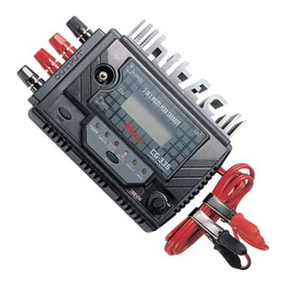
Hi-Tec
Hi-Tec CG-330 User manual

Hi-Tec
Hi-Tec RDX2 Mini User manual
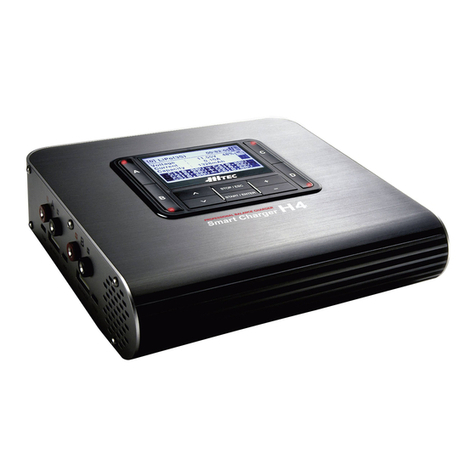
Hi-Tec
Hi-Tec Smart Charger H4 User manual
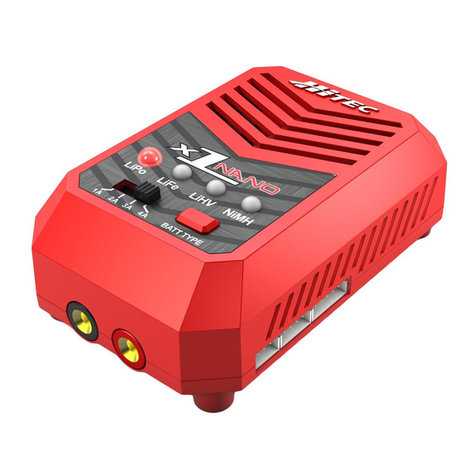
Hi-Tec
Hi-Tec X1 Nano User manual
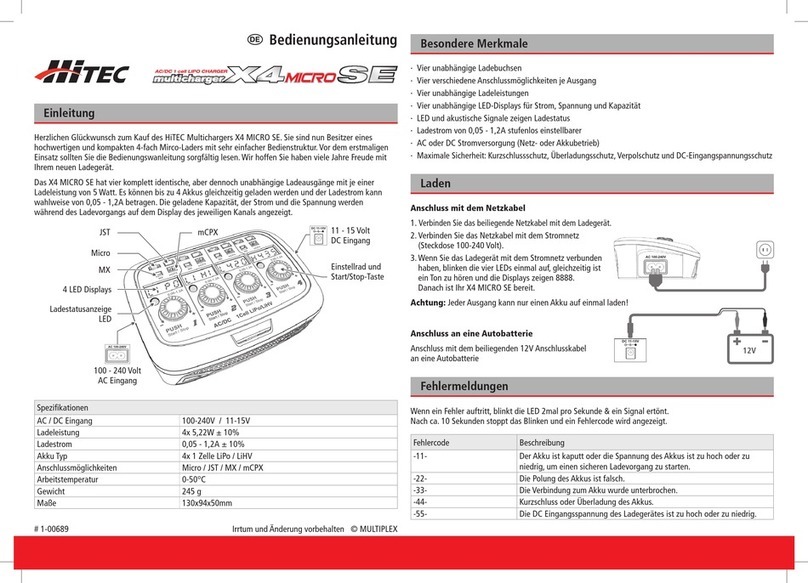
Hi-Tec
Hi-Tec X4 MICRO SE User manual
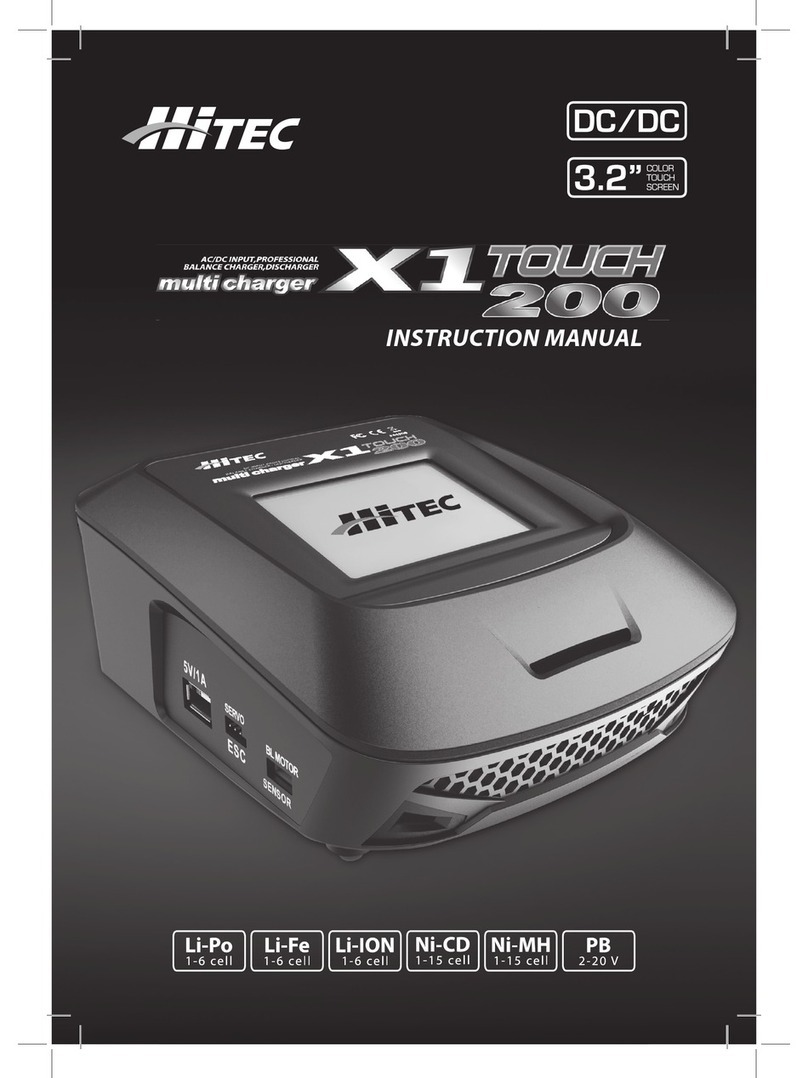
Hi-Tec
Hi-Tec X1-200 Touch User manual
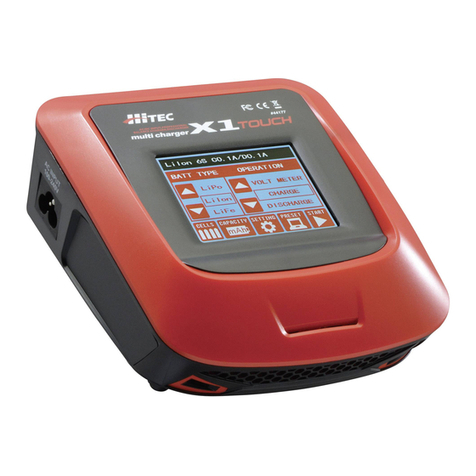
Hi-Tec
Hi-Tec X1 Touch User manual
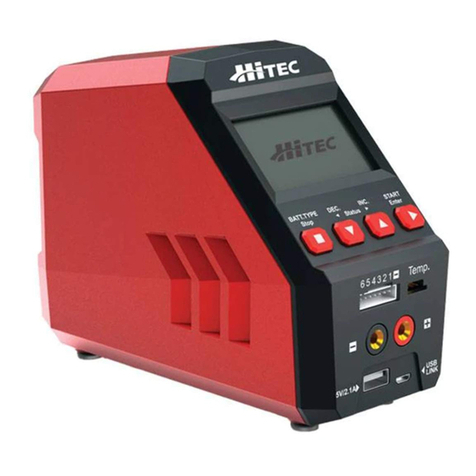
Hi-Tec
Hi-Tec RDX1 PRO User manual
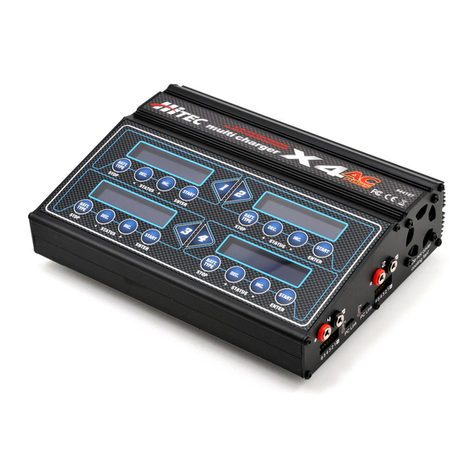
Hi-Tec
Hi-Tec multi cahrger X4 AC Plus User manual
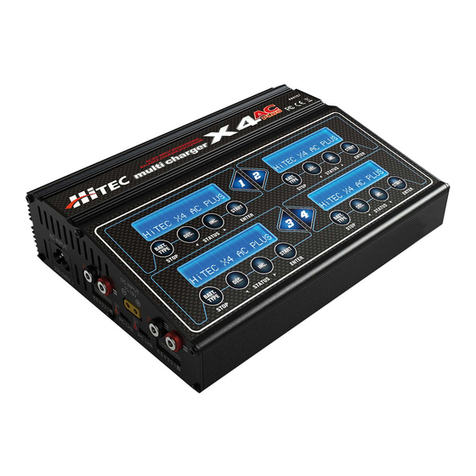
Hi-Tec
Hi-Tec X4AC PLUS User manual

Hi-Tec
Hi-Tec X4 AC Pro User manual
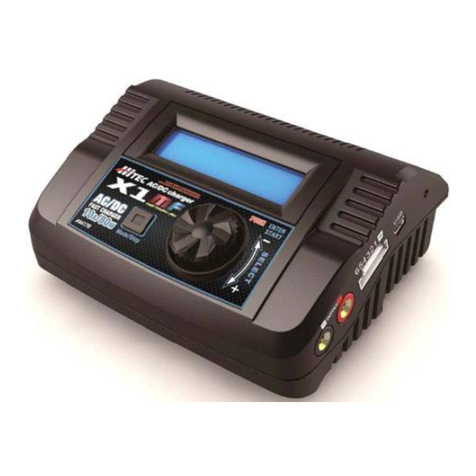
Hi-Tec
Hi-Tec X1MF User manual

Hi-Tec
Hi-Tec Smart Charger H4 User manual
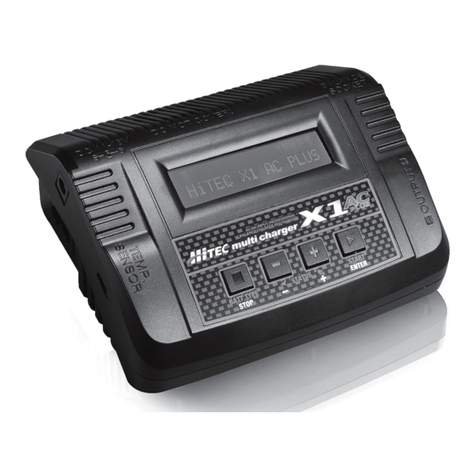
Hi-Tec
Hi-Tec X1 Touch User manual
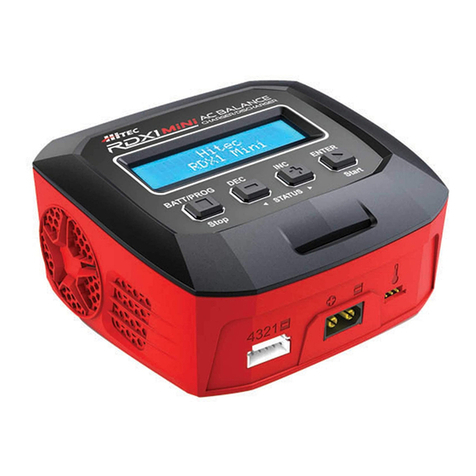
Hi-Tec
Hi-Tec RDX1 Mini User manual
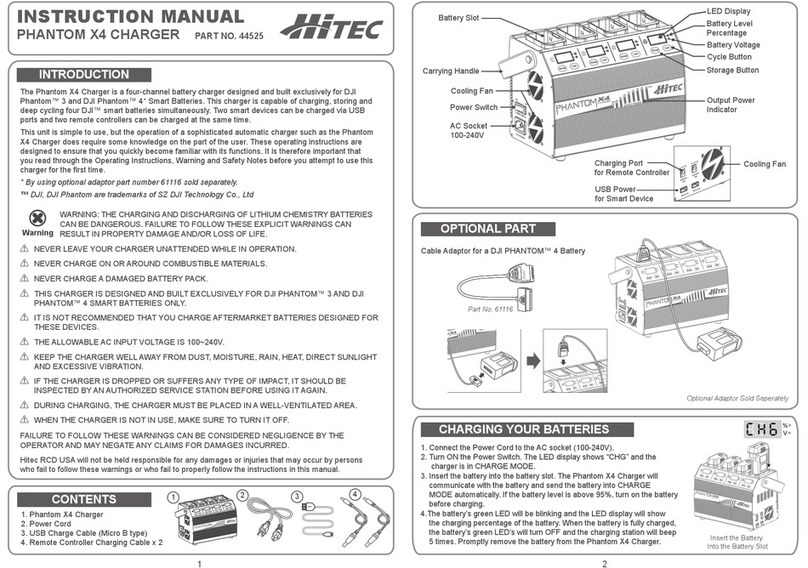
Hi-Tec
Hi-Tec 44525 User manual

Hi-Tec
Hi-Tec 44246 User manual
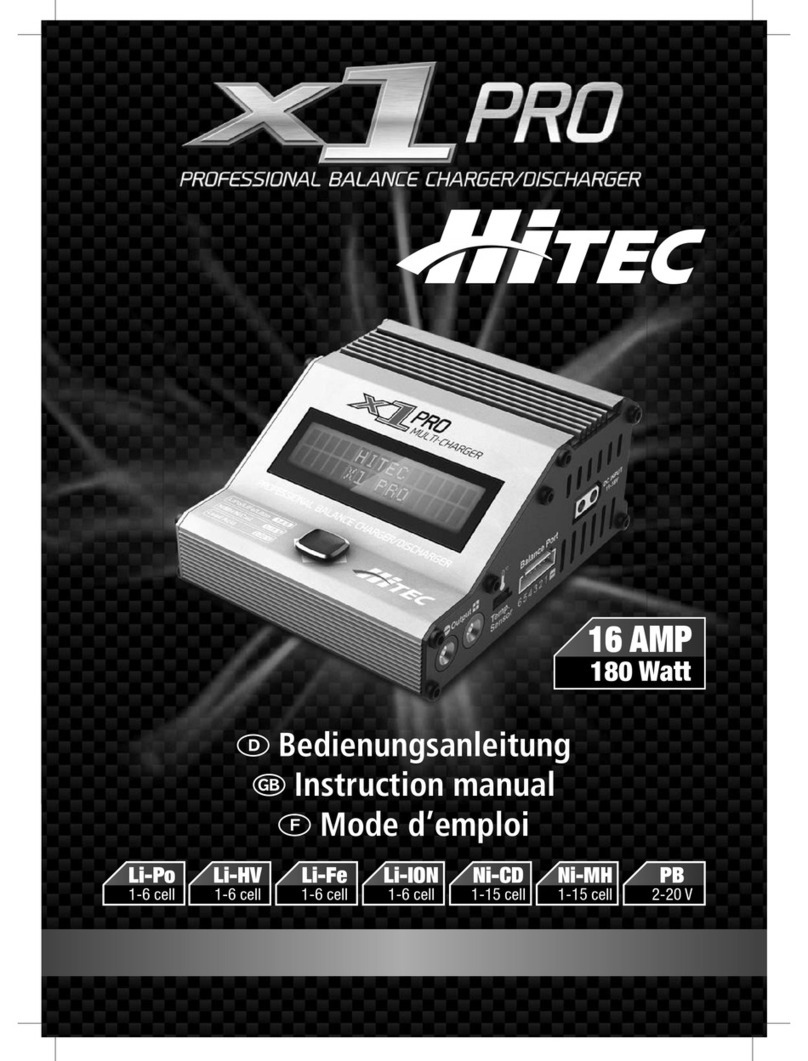
Hi-Tec
Hi-Tec X1 Pro User manual

Hi-Tec
Hi-Tec RDX1 Mini User manual

Hi-Tec
Hi-Tec RDX1 Mini User manual
